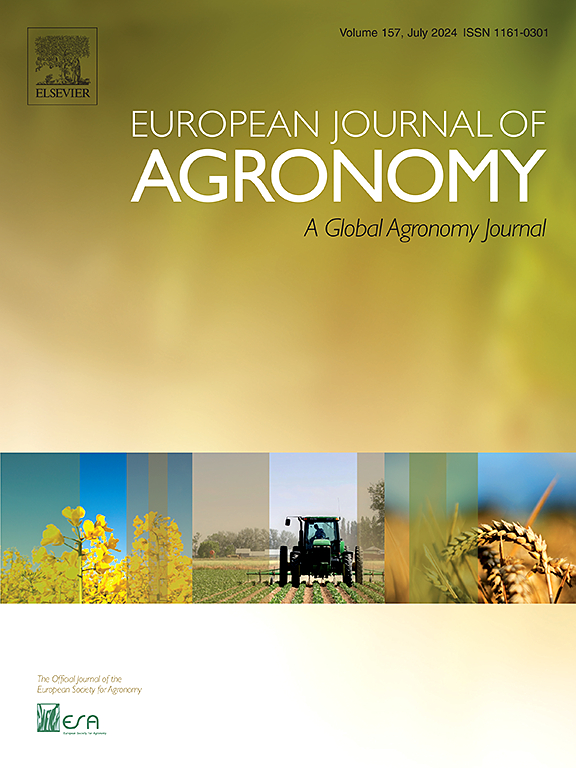Enhancing water use efficiency in wheat: 40 Years of genetic gains in the Argentine Pampas
IF 4.5
1区 农林科学
Q1 AGRONOMY
引用次数: 0
Abstract
Understanding the impact of breeding on water use and productivity, particularly in underexplored environments where pre-anthesis rainfall is often limited, is crucial for increasing wheat grain yield (GY) under future climatic scenarios. The aim of this work was to study the effects of breeding on GY and its physiological determinants, including water use and water use efficiency among cultivars released to the Argentine market over a 40-year period. Ten Argentinean cultivars classified into early cycle (EC) and late cycle (LC), based on time to anthesis, were grown across three seasons (2015, 2016, and 2017) under irrigated, rainfed, and water restricted conditions. Breeding increased GY by enhancing the harvest index (HI) in LC cultivars and the total biomass (BT) in EC cultivars. These improvements were accompanied by increases in water use efficiency for grain yield production (WUEGY,ETc) of 1.11 % and 0.45 % per year among LC and EC cultivars, respectively, and a 0.29 % per year improvement in water use efficiency for biomass production (WUEBT,ETc) among EC cultivars. Crop evapotranspiration (ETC) decreased by 0.16 % per year exclusively in LC cultivars. Transpiration use efficiency (TE) improved by 0.55 % and 0.45 % per year for LC and EC cultivars, respectively, driven by increases in radiation use efficiency (RUE) of 0.46 % and 0.24 % per year. Notably, no changes in canopy conductance (gC) were observed. Finally, the proportion of water transpired before anthesis (pPREANT TC) decreased by 0.45 % per year in LC cultivars. The results of this study indicate that genetic improvement in Argentina has enhanced GY by increasing WUE and RUE, rather than total ETC. This is a particularly beneficial outcome for rainfed farming systems with limited water availability
提高小麦水分利用效率:阿根廷潘帕斯草原40年遗传收获
了解育种对水资源利用和生产力的影响,特别是在开花前降雨往往有限的未开发环境中,对于在未来气候情景下提高小麦产量至关重要。本研究的目的是研究在40年的时间里,在阿根廷市场上投放的品种中,育种对水稻产量及其生理决定因素的影响,包括水分利用和水分利用效率。10个阿根廷品种,根据开花时间分为早周期(EC)和晚周期(LC),在灌溉、雨养和限水条件下,分三个季节(2015年、2016年和2017年)生长。育种通过提高LC品种的收获指数(HI)和EC品种的总生物量(BT)来提高GY。与此同时,LC和EC品种的粮食生产用水效率(WUEGY等)分别提高了每年1.11 %和0.45 %,EC品种的生物质生产用水效率(WUEBT等)提高了每年0.29 %。LC品种的作物蒸散量(ETC)每年下降0.16 %。在辐射利用效率(RUE)每年提高0.46 %和0.24 %的带动下,LC和EC品种蒸腾利用效率(TE)分别提高了0.55 %和0.45 %。值得注意的是,冠层电导(gC)没有变化。最后,LC品种花前蒸腾水分比例(pPREANT TC)以每年0.45 %的速度下降。本研究结果表明,阿根廷的遗传改良通过提高WUE和RUE而不是总ETC来提高GY。对于用水有限的雨养农业系统来说,这是一个特别有益的结果
本文章由计算机程序翻译,如有差异,请以英文原文为准。
求助全文
约1分钟内获得全文
求助全文
来源期刊

European Journal of Agronomy
农林科学-农艺学
CiteScore
8.30
自引率
7.70%
发文量
187
审稿时长
4.5 months
期刊介绍:
The European Journal of Agronomy, the official journal of the European Society for Agronomy, publishes original research papers reporting experimental and theoretical contributions to field-based agronomy and crop science. The journal will consider research at the field level for agricultural, horticultural and tree crops, that uses comprehensive and explanatory approaches. The EJA covers the following topics:
crop physiology
crop production and management including irrigation, fertilization and soil management
agroclimatology and modelling
plant-soil relationships
crop quality and post-harvest physiology
farming and cropping systems
agroecosystems and the environment
crop-weed interactions and management
organic farming
horticultural crops
papers from the European Society for Agronomy bi-annual meetings
In determining the suitability of submitted articles for publication, particular scrutiny is placed on the degree of novelty and significance of the research and the extent to which it adds to existing knowledge in agronomy.
 求助内容:
求助内容: 应助结果提醒方式:
应助结果提醒方式:


